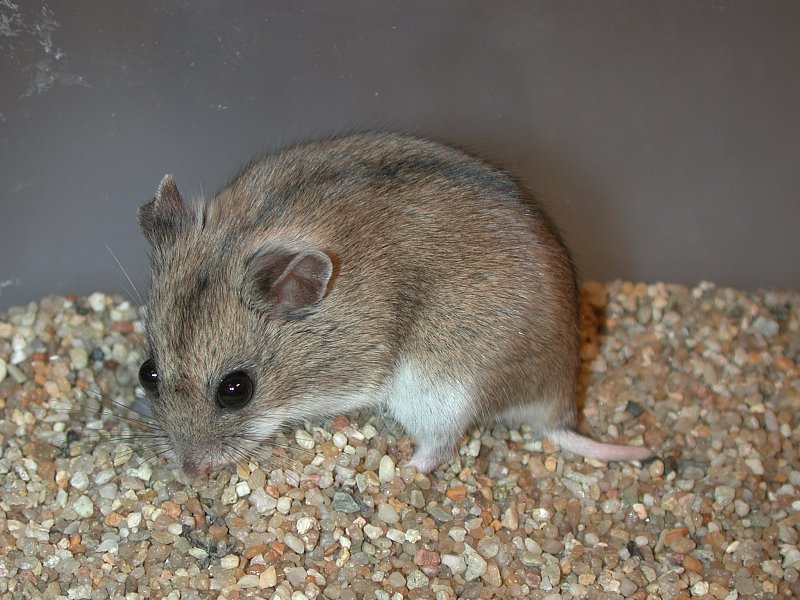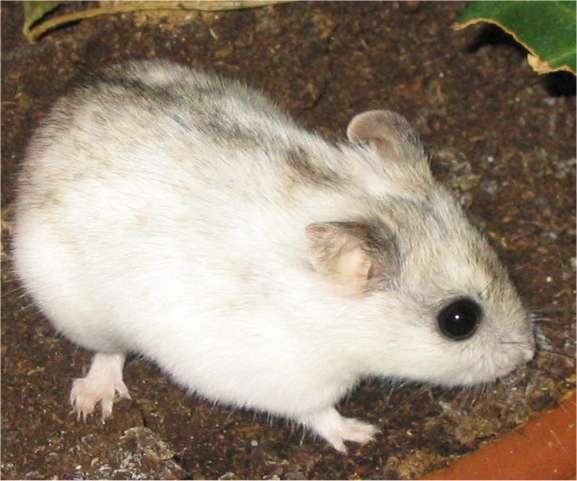Cricetulus
Chinese hamster strip ( Cricetulus barabensis griseus ), bright breeding form
The Grey Dwarf Hamster or gray hamster ( Cricetulus ) are a genus of hamsters, are counted among the six species. Because external similarities with rats, these animals have in English the name Ratlike hamster ( " rat -like hamsters "); but another type is passed as a rat -like hamsters in the German language that does not belong in this genus.
Features
These hamsters can reach head fuselage lengths between 75 and 120 millimeters, which must be added 20 to 50 mm tail come. Her long coat is usually gray in color at the top, sometimes with a reddish tinge. The underside and paws and the tail are light gray or white. Some species can also be white patterned addition, a way of Daurian dwarf hamster has a dark dorsal stripe. All species have a stocky build with relatively short legs. The head is characterized by the blunt snout and large cheek pouches.
Distribution and habitat
Grey Dwarf Hamsters are native to Eurasia, their range extends from southeast Europe over large parts of Central Asia up to the northern East Asia. Their habitat is dry steppes and semi-desert regions such, they also come in mountainous regions up to 3600 meters above sea level before.
Way of life
Gray dwarf hamsters live in self-dug burrows which may extend up to 1.2 meters into the earth. In this building they sleep and store their food supplies. The animals are more active at night, in the spring and summer they go but also during the day in search of food. During the cold season they hold no continuous winter dormancy, but to watch from time to to time to eat stored food. You are likely to live solitary and be very aggressive towards conspecifics.
They feed mainly on seeds and stems to their preferred food include soybeans, peas and millet grains. Occasionally they also eat insects and animals in captivity is reported that they have killed and eaten frogs and gerbils. The back pockets are very large and allow the transport of large amounts of food to build. A single animal was once found with 42 soybeans in its cheek pouches.
Up to three or four times per year, the female gives birth after about 17 - to 22 -day gestation period of five to six (in exceptional cases up to ten) young. Most births fall in the months of February to October. The young grow rapidly and are already fully grown at two months.
System
The genre of horror dwarf hamster is divided into eight types:
- The gray dwarf hamster ( Cricetulus migratorius ) is spread from the Balkans and Southern Russia and Kazakhstan to in northern China and Mongolia.
- The Daurian dwarf hamster ( Cricetulus barabensis ) differs by a dark dorsal stripe from the other species. His home is the southern and south-eastern Siberia, Mongolia, northern China and Korea. The Chinese dwarf hamster, which is widely used as home and laboratory animal is sometimes performed as a separate species ( Cricetulus griseus ), but is considered to be conspecific with the Daurian dwarf hamsters. Also, the Trans-Baikal dwarf hamster ( Cricetulus pseudogriseus ), which is sometimes regarded as a separate species, according to recent studies, is a subspecies of Daurian dwarf hamster.
- The Sokolow - dwarf hamster ( Cricetulus sokolovi ) is native to Mongolia and Inner Mongolia.
- The long-tailed hamster ( Cricetulus longicaudatus ) differs by the eponymous longer tail of the other species. The species lives in Mongolia and adjacent parts of Russia ( Altai region and Tuva ) and in the northern and western China.
- The four types of Tibetan Dwarf Hamster ( subgenus Urocricetus ) live in the highlands of Tibet, the extreme north of India and western Nepal.
The Genera of the Central Great Dwarf Hamster ( Allocricetulus ), Gansu Hamster ( Cansumys ) and rat -like hamsters ( Tscherskia ) were formerly sometimes performed as subgenera of Cricetulus are today, however, recognized as a distinct species.










